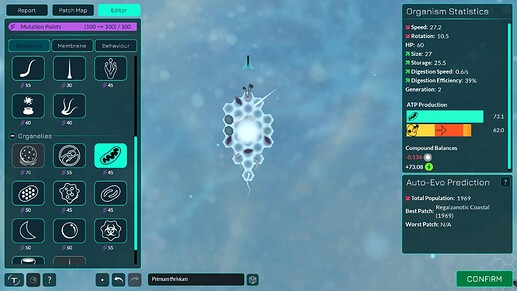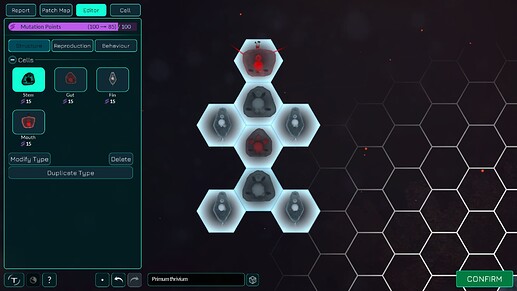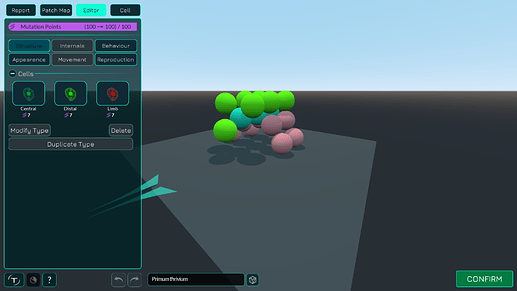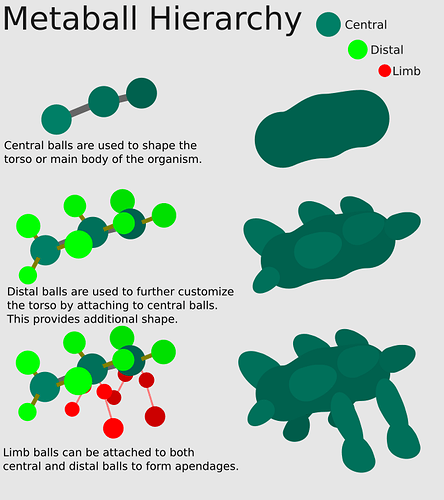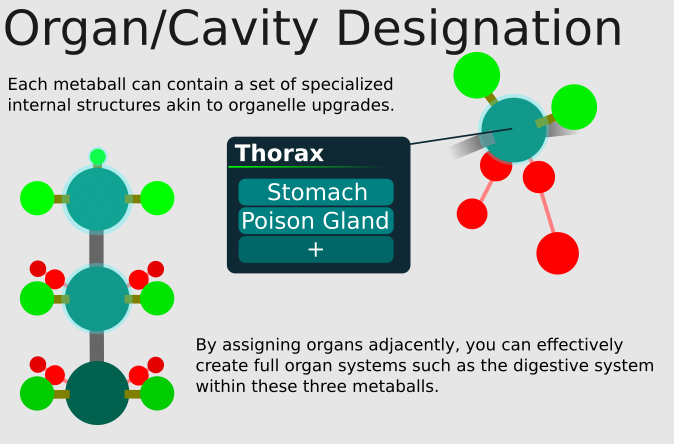After reading through the ideas and thoughts provided by Deus, I have decided to go about designing the macroscopic editor proper, and how the player’s creature can be modeled. I have taken what I have learned from player interaction with our prototypes made by Hhyyrylainen to reimagine the editor as (I hope) a more intuitive form compared to previous iterations.
Overview
The macroscopic editor is the apex of creature creation in Thrive. It is at this stage that the player goes on to create a complete being using all that they had learned and created in past stages. Our goal is to make sure that all of the design choices the player has made in previous stages continue to play a part here.
Before I begin, I will go over each editor and how they relate to each other. This is optional reading, and may be skipped over.
Optional Text Dump
Microbe Stage
When the player first reproduces, they are presented with the microbe editor, and a single hex of cytoplasm.
From the very beginning they are assaulted with a large array of options and potential choices that can be quite overwhelming. Luckily, the life of a microbe is not immediately demanding of utmost efficiency and so they are granted some freedom to experiment and learn.
This stage teaches the player how to balance their energy consumption, the foundations of building an efficient cell, and how to occupy a given niche using their parts.
Multicellular Stage
Having successfully built a cell capable of surviving the trials of the primordial soup, the player will now have accessed the multicellular editor.
Suddenly the player is presented with an entirely new layer to the editor! Not only are they able to plan out a body-plan for a creature larger than one cell, but they are also now able to create multiple variations of their original cell.
This opens up a significant level of customization, but also more complexity that they must learn.
This stage teaches the player how to manage different cell and tissue types in one creature, how to coordinate energy balance and metabolism between specialized cells, and how to form a cohesive body plan.
Macroscopic Stage
Having survived to become an increasingly elaborate organism, the player will have now accessed the macroscopic editor, and final stage of customization.
The player is suddenly no longer constrained to a 2D plane, and is now able to form a completely cohesive body structure instead of a loose cluster of specialize cells.
In this final stage, the player will learn how to use their specialized cells to create organ structures throughout the creature, coordinate organs to form organ systems, and form a cohesive creature made of flesh and blood.
As of now, we have a macroscopic editor prototype, that while fun to use, is ultimately a messy and unintuitive affair. The player begins with a nondescript cluster of metaballs loosely resembling their multicellular body plan, upon which more cells can be added to the pile by haphazardly attaching more.
What this editor currently lacks is a form of concrete and cohesive structure that the player can build onto. And so, the following concept aims to rectify this shortcoming.
By introducing hierarchical definition to the metaballs, we can easily grant each part of the player’s organism an identifiable definition and shape. The resulting layout is easy to understand, and easier to modify. This also allows us to better designate parts for mechanical and animation purposes.
Metaballs will be categorized into three separate varieties and levels of hierarchy.
Central metaballs are the backbone of the organism, and form the overall body-shape. Centrals can only be connected to others of the same hierarchy, and at least one must always exist within the creature. New centrals are created by extending from another, creating a “spine”.
Distal metaballs are the accents and details of the organism, and grant the organism detailed shape. Distals must always be connected to a parent central ball either directly or via another distal. These balls act as direct extensions of their parent centrals, moving with their parent’s motions. Copying (Or removing) a central will bring all of the attached distals alongside it, allowing for effective segmentation and expansion.
Limb metaballs are strictly used to define parts of the organism as posable appendages. This allows players (and the game itself) to easily recognize and define specific parts as animated limbs instead of static parts of their torso. Limbs may be placed upon distals or directly upon centrals, while only other limbs can be placed upon themselves.
With this metaball hierarchy in place, the macroscopic editor becomes navigable and comprehensive to both the player and computer.
A question remains however; Where will the player’s specialized cells come into play here? How will they be assigned throughout the organism if not ball by ball? The answer to this is organs!
Each cell created by the player will be assigned either to metaballs (both central and distal) within the organism as specialized organs, or as the dermis that composes their hide. Each metaball can contain several organs at once or none at all, allowing for clever allocation of internal characteristics in the organism.
Organs can take on various forms that define their basal characteristics, which are then further modified by the cells that compose them.
Connective organs such as nerves, muscles, blood or fat. These broadly defined organs span the length of a bodypart, and grant various benefits based largely on the characteristics of the cells themselves. Most notably to bridge between other organs. They are the default organ type that the player’s specialized cells will initially be defined as upon entering the stage.
Cavity organs such as stomachs and bladders. These are used to hold and/or process matter that otherwise wouldn’t be held within the cells themselves.
Orifice organs are gateways between the organism’s internals and the outside world for better and worse. These are used to exchange large amounts of matter with the world at large.
Sensory organs are externally exposed receptors such as eyes, ears, and noses. These are used to analyze the surrounding world, but as such are also quite vulnerable.
Dermal organs are the skin and armor of an organism. The primary dermal cell encompasses the entirety of the organism unless otherwise specified on specific metaballs by creating a dermal organ which overrides it with another cell of choice. This can be used to create armored portions of the body, or perhaps toxic regions.
By default, the first cell in the player’s organism becomes the dermis, while the cells derived from the original become organs held within the initial central metaball. The player can then remove these organs if necessary, or choose to expand them into more specialized and effective roles. Organs are copied or deleted alongside their parent metaball, but can also be copied and deleted between metaballs themselves.
The attachment of organs to the metaballs themselves allows for relatively intuitive customization analogous to the upgrades system for organelles in the cell editor. This grants familiarity and initial understanding for players, while also avoiding the pitfall of having to loosely attach physical organs to a body.
Synopsis
By creating a hierarchical structure for metaballs, the macroscopic editor is more easily understood by player and computer both. The player’s specialized cells from prior stages become the skin and organs of the creature, maintaining continuity and carrying over the player’s past choices. The overall design invokes analogies of concepts already explored by previous editors, allowing a sense of familiarity and understanding.
